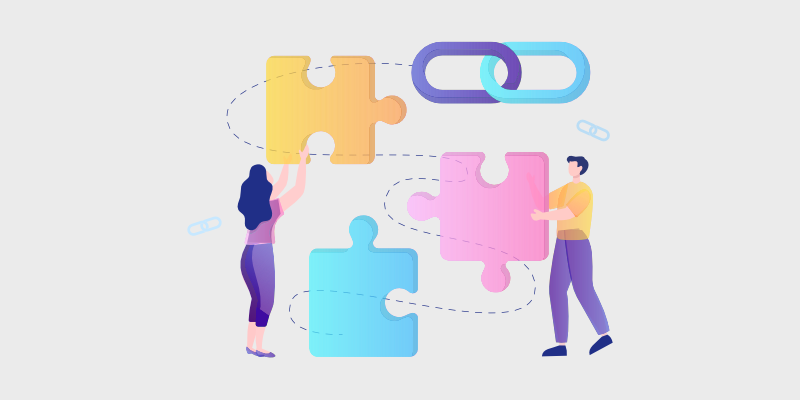
A re you wondering what the best internal linking strategies are?
You’re in the right place! I’m about to share internal linking best practices and how to use them to improve your blog’s SEO.
When you create a new blog, getting it to rank in search engines like Google is one of the best ways to grow traffic and earn money.
However, to become worthy enough to rank on Google search results, you need to follow certain SEO strategies, one of which is internal linking.
Internal linking is a pretty simple concept; all you have to do is connect web pages (or blogs) on your website with each other using hyperlinks. However, to get the best results, you need to be strategic about it.
In this guide, we’ll go over some of the most effective internal linking best practices that you NEED to implement to make your blog a success.
In This Guide:
Let’s begin with some key takeaways:
Key Takeaways On Best Internal Linking Practices
- Link to relevant, contextual content to help users and search engines better navigate your site
- Use descriptive keywords in your anchor text to signal what the linked page is about
- Open internal links in the same tab/window for a better user experience
- There are two types of links; dofollow and nofollow. Use “dofollow” to make crawling easier and pass link equity
- Don’t overdo it – stick to a reasonable number of links per page based on content length
- Use a tool like the AIOSEO Link Assistant to easily audit and optimize your internal linking structure
Now, if you’re still unfamiliar with internal linking, let’s go over what it is and why it’s important…
What is Internal Linking?
Internal links are hyperlinks that point one page to another page on the same site. Here’s an example:
At Blog Tryant, we wrote a blog post on how to drive more traffic to your blog.
The clickable link above connects this blog post to another relevant blog post on our site.
These are different from external links, which link out to web pages on other websites.
Check out this tutorial if you need help adding links in WordPress.
Why Internal Links Are Important For SEO
The point of adding internal links is to help both search engines and readers find relevant content on your website.
Let’s take a look at what benefits you’ll get from a good internal link structure and strategy:
Increase Site Ranking ⭐
Google has to constantly scout for new pages to add to their directory and place them in search results. Some site pages are known to Google because they’ve previously visited them, while others are discovered when Google follows a link from a known page to a new page.
That’s what internal linking does. It helps Google discover new content faster so it has a better chance to rank in search results.
By using internal links, you can also show Google which content is most important. For example, let’s say you have a photography blog, and each of your blog posts links to a valuable guide on how to become a photographer. With multiple internal links pointing to that guide, Google sees that it’s a high-value article and an important page for the site, increasing its chances of ranking even higher.
Improve Blog Navigation ⭐
Users can find their way around your site using navigational links such as the ones in your header menu and footer links. These could be links to your about page, category page, product page, or landing page with a call-to-action.
But, it’s also important to add contextual links to help readers navigate your blog.
Contextual links are links within the body of a post or page that lead to related articles and content. These links will help you get all of your posts and pages linked internally. As a result, readers will be able to easily discover more of your content.
Boost Engagement ⭐
With improved blog navigation, you can also boost your blog’s engagement. As we mentioned above, internal linking helps readers find your content easier. So, that means there’s a better chance of them reading more of your blog posts and staying on your site longer.
This reduces your bounce rate, and because users spend more time on your site, you have a better chance of getting more comments, email subscribers, and even customers.
Alright, now that you know the benefits of different types of internal links, let’s explore some strategies for improving your blog’s internal linking structure…
Internal Linking Best Practices: 5 Effective Tips
Creating a strong internal linking structure is crucial for on-page SEO and getting higher up in search engine rankings.
By realizing the importance of internal linking early on, bloggers and website owners can save tons of time and see immediate results when their links pass value to low-performing pages.
Let’s go over the 5 internal linking best practices to adopt today:
1. Link to Relevant Content
The first step to creating an effective internal linking strategy is to figure out:
- What content do you want to link to
- Which posts or pages on your website do you want to link that content from
Some experts recommend setting up a complex structure of pages (also known as content “silos”) to link to. But in our opinion, it doesn’t have to be that complicated.
The most important thing when it comes to internal link-building is relevance. If you have an article about traveling to Europe and you internal link to an article about video games, that’s not helpful or relevant to readers.
Instead, your internal links should provide value to readers. In an article about traveling to Europe, you can create internal links to relevant blog topics you’ve written about such as:
- Budget airlines in Europe
- Purchasing travel insurance
- Best restaurants in Europe
- And so on
Linking to relevant content is also easier when you create groups of content. For example, a travel blog can write a guide about traveling in Canada and create additional specific articles on Newfoundland, British Columbia, Quebec, etc. Then, interlink all of these relevant posts together.
This will make it easier for readers to navigate your site and they’ll be more likely to click on your internal links. Plus, it will help search engines better understand what your site is about.
2. Use Keywords in the Anchor Text
The next most important tip is to use anchor text wisely.
Anchor text is the visible, clickable words of a hyperlink.
Anchor text is the visible, clickable words of a hyperlink.
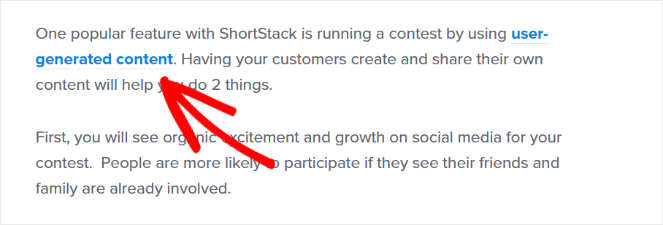
In the example below from OptinMonster, the anchor text reads “user-generated content.”
When users click on the link, it will take them to an article about the topic of user-generated content. “User-generated content” is also the primary keyword of the article that’s linked.
So, instead of linking that article to random words in the post like “customers,” OptinMonster uses keywords as anchor text.
By using descriptive keywords in your anchor text, you can help Google understand that your links are useful and relevant, which can improve keyword rankings.
This also makes it easy for readers to understand what you’re linking to and encourages them to click.
Remember: Be sure that you’re using anchor text naturally and don’t internal link to the same keyword repeatedly in one article. This can alert Google that something spammy is going on.
3. Open Internal Links in the Same Tab
A lot of people wonder if an internal link should open in a new tab or in the same tab.
At Blog Tyrant, our opinion is that as long as you’re linking to another page or post on your site, your links should open up in the same tab.
This is pretty standard practice and makes the most sense for the user experience.
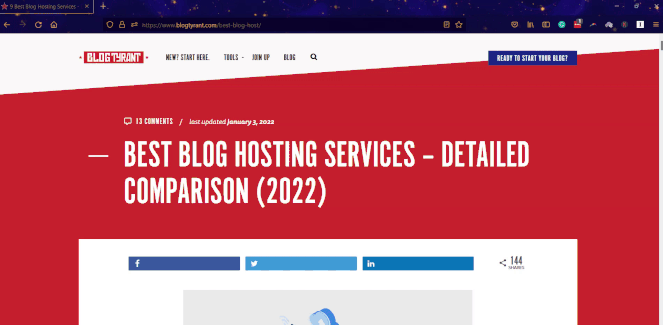
Visitors can easily use your navigation menu or the back button in their browser if they need to return to where they started.
But, for external links, which would lead users to a different site other than your own, those should open in a new tab. That way, it’s easier for users to return to what they were originally reading on your blog and you can keep them on your site for longer.
Read this tutorial to learn how to open external links in a new window or tab with WordPress.
4. Use DoFollow Links To Pass Link Juice
Now, let’s go over whether your internal links should be “dofollow” or “nofollow.”
With dofollow links, search engines can follow every link on your site.
On the other hand, a nofollow link is a link from your site to another site that you don’t want to pass link juice to. It tells Google not to follow that link or give any link value to it.
So, internal links should always be dofollow so that Google and other search engines can go freely from one internal page of your site to the next.
Luckily, all internal and external links are dofollow by default, unless you change them to nofollow links.
Check out this article to learn more about the difference between dofollow and nofollow links.
Next, let’s answer a common question, how many internal links are good for SEO?
5. Don’t Use Too Many Internal Links
There’s no right or wrong number of internal links that you should add to a page or post. Google itself says to use “a reasonable amount.”
But, it’s important not to overwhelm your readers with too many internal links on a page.
Take a look at this example below:

This one, short paragraph has 6 links in it. It makes the text harder to read and users are probably not going to click on any of those links—they’re just too many.
Instead, spread those links throughout your article, adding them to sections where they are most useful and relevant to readers.
Also, consider the length of your blog posts. Add fewer internal links to short posts and add a little more to longer posts.
That’s it for this list of internal linking best practices.
Before you go, we want to share the best internal linking software on the market…
Internal Linking Strategies Made Easy with AIOSEO
Manually searching through your site and figuring out what to link to and where can be really time-consuming.
Luckily, you can use a plugin like All in One SEO to make internal linking super easy.
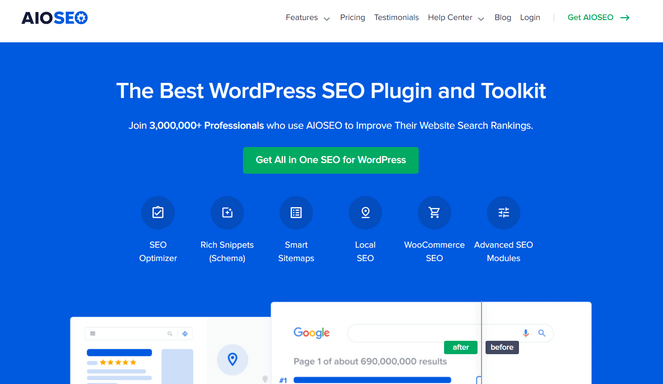
All in One SEO (AIOSEO) is the best SEO plugin for WordPress. It can help you optimize your site for SEO in under 10 minutes. Plus, it has features like smart XML sitemaps, TruSEO on-page analysis, rich snippets schema, and much more.
But, what really sets AIOSEO apart from other SEO plugins is its powerful Link Assistant feature.
AIOSEO’s Link Assistant will automatically crawl all of your pages and generate an Internal Links Report for your website.
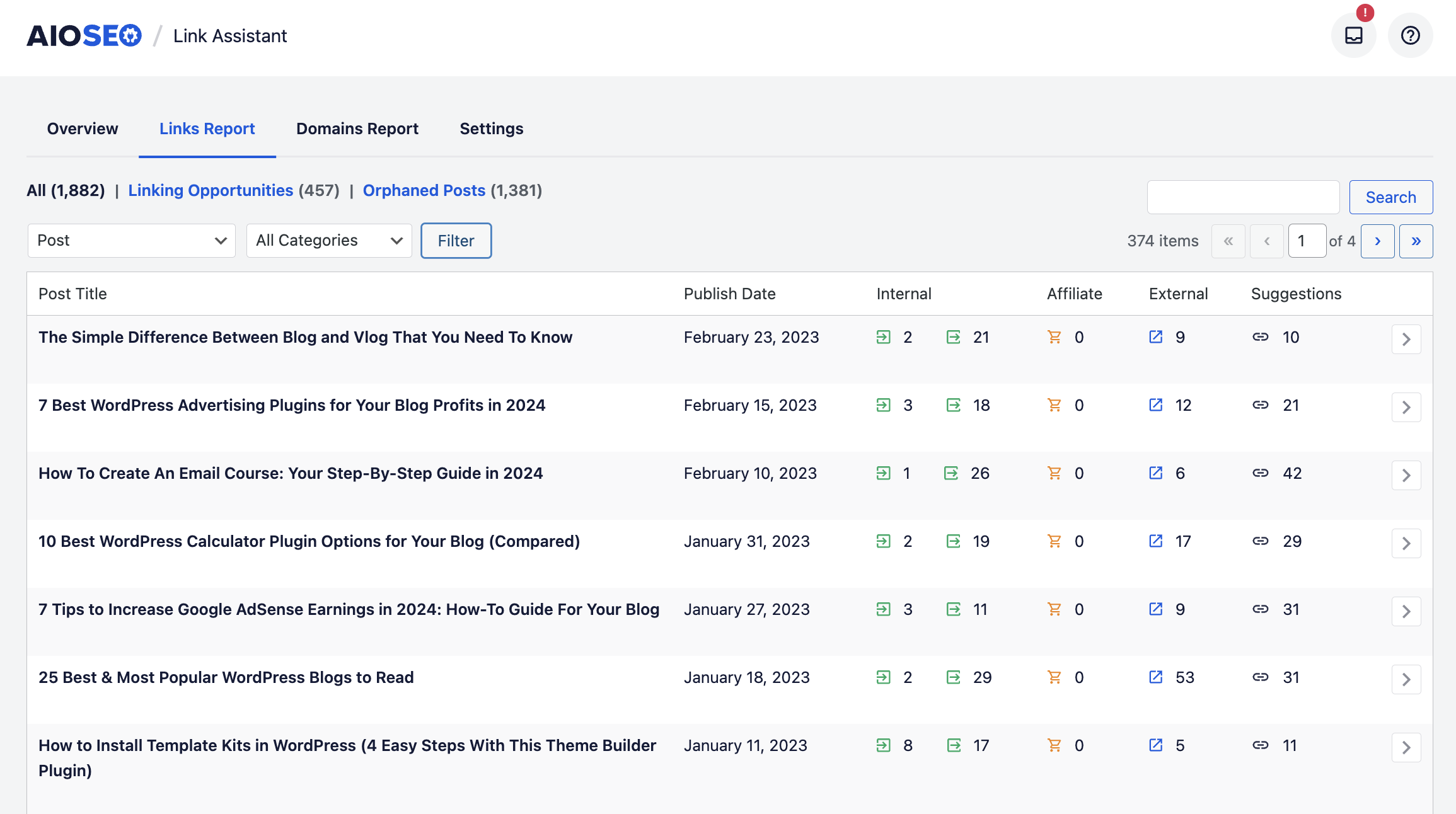
This makes it easy to do an internal linking audit because it will give you insight into:
- Linking Opportunities – AIOSEO recommends relevant pages of your website you can link to and anchor text you can use.
- Orphaned Posts – AIOSEO finds all of the orphan pages on your site (pages with no internal links throughout) and offers linking suggestions.
You don’t even have to manually add the links yourself with AIOSEO. When the Link Assistant gives you a suggestion, simply click the Add Link button to automatically add outbound or inbound internal link to your post.
Here’s what it looks like for this post:
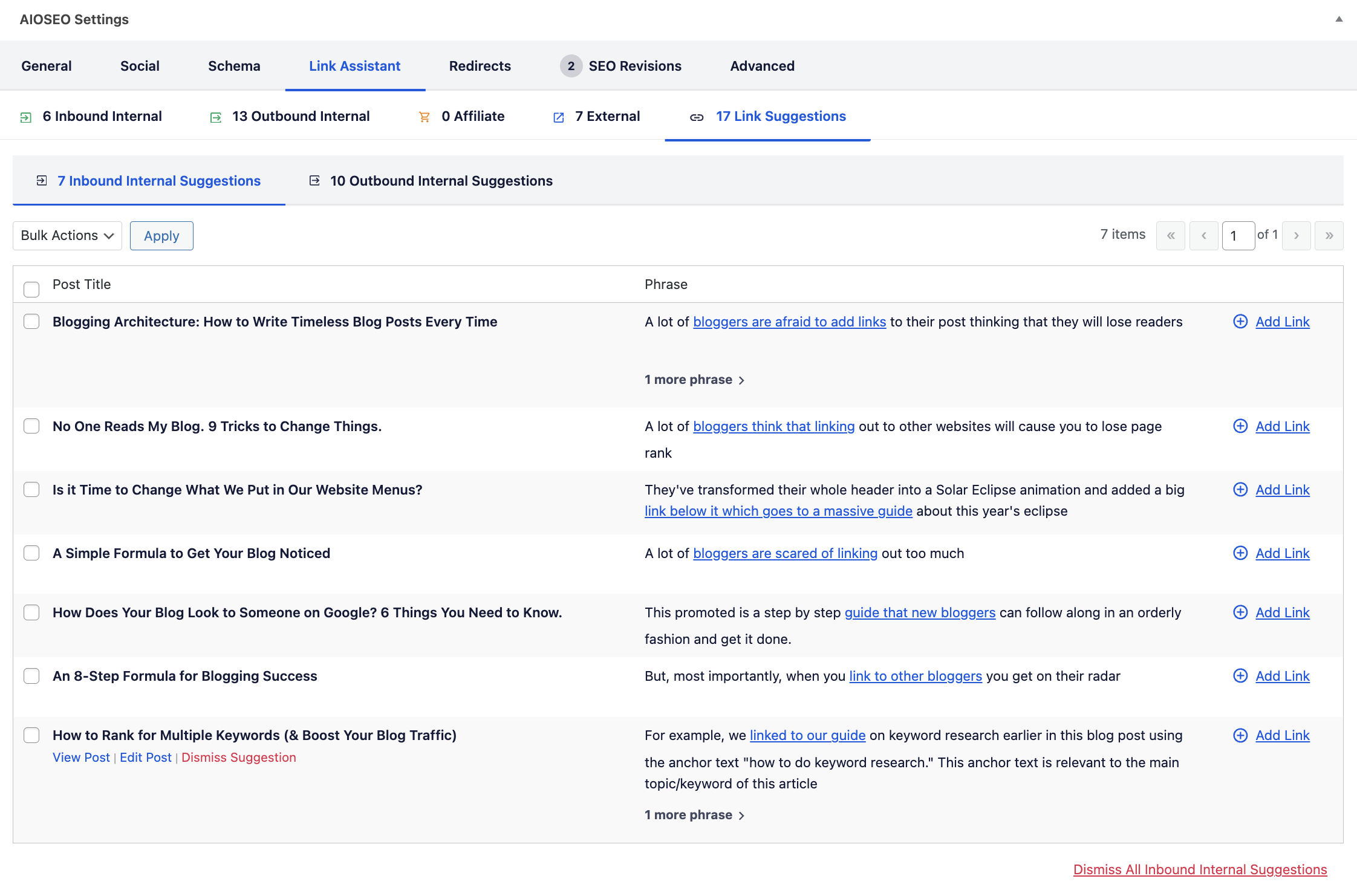
If you want to change the anchor text or placement of an internal link, you don’t have to open your blog post and manually edit it anymore either.
With AIOSEO’s Link Assistant, you make those changes in 1-click. Just hover over the link suggestion and click on the Edit icon to make your changes or fix any broken internal links.
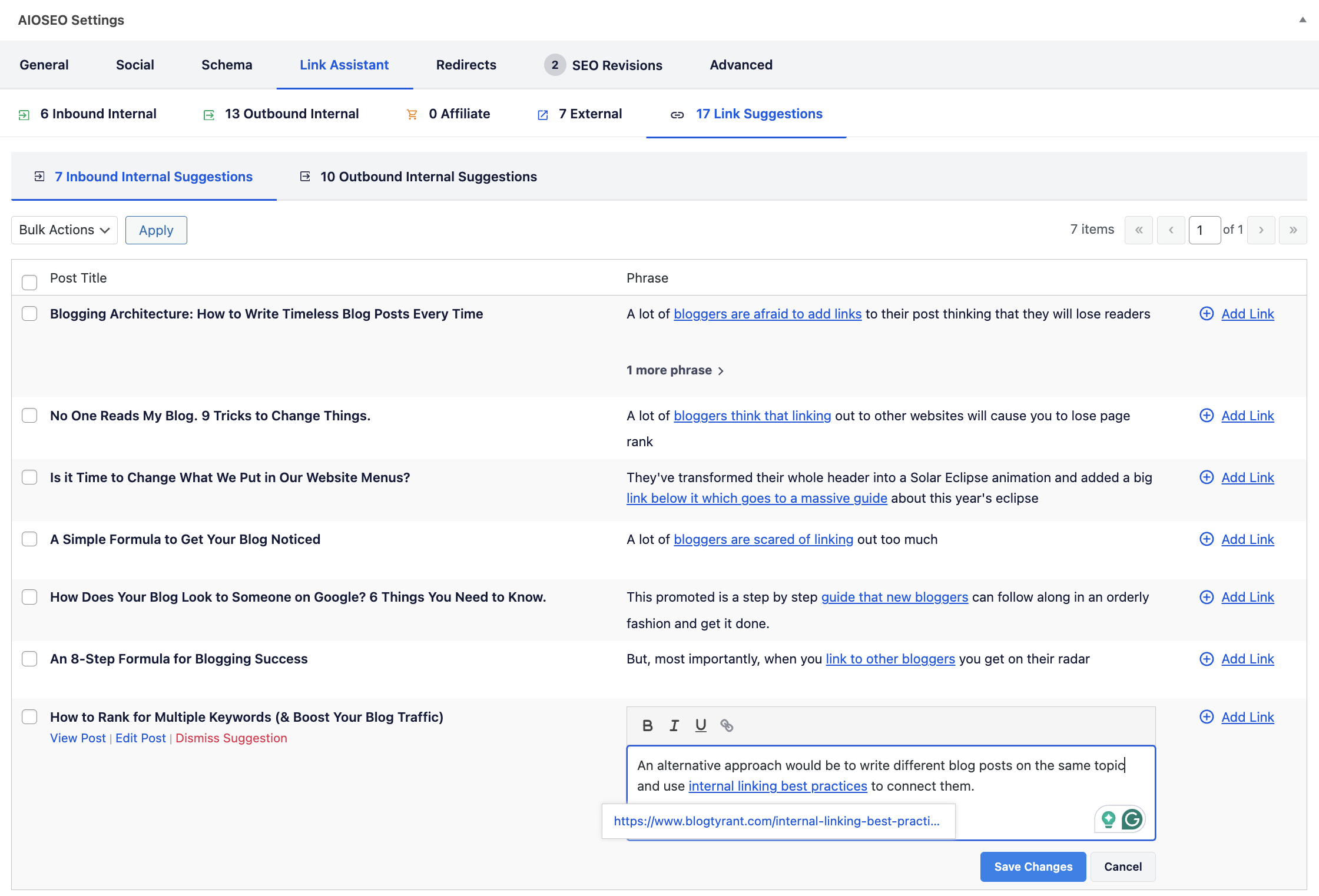
With AIOSEO, internal linking has never been easier!
The Link Assistant add-on can also help you organize your site’s external links. Using the Domain Report, you can see which external links aren’t adding value to your content and you can delete them with one click. You can also edit or update any external links right from the Link Assistant.
You can learn more about this powerful plugin in our detailed AIOSEO review.
Best Practices of Internal Link Structure in Closing
That’s a wrap! We hope this guide will help you get started on internal linking. Understanding the five internal linking best practices we mentioned above is important for SEO.
Just make sure not to add too many links and point to the right target page, and you’re good to go. With the above tips, you’ll quickly rank higher in search engines and drive more traffic to your site.
If you liked this post, then check out our guide on how to get backlinks for your blog, which is another important SEO ranking factor.
And don’t forget to sign up for our email newsletter for more helpful blogging tips!


As being a blogger this is the best advice I can get. Thanks.
Very helpfull information thanku